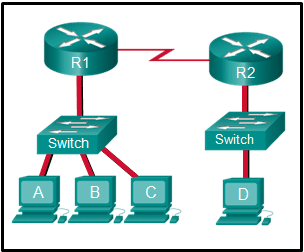Refer to the exhibit. The switches have a default configuration. Host A needs to communicate with host D, but host A does not have the MAC address for the default gateway. Which network devices will receive the ARP request sent by host A?

- only hosts A, B, C, and D
- only hosts A, B, and C
- only host D
- only hosts B, C, and router R1
- only router R1
- only hosts B and C
| Explanation & Hint:
In the scenario where Host A needs to communicate with Host D and does not have the MAC address for the default gateway, the behavior of the ARP (Address Resolution Protocol) request depends on the network setup, particularly how the hosts and the router (default gateway) are connected via switches. Given that the switches have a default configuration and assuming that Host A, Host B, Host C, Host D, and router R1 are all connected to these switches in the same broadcast domain (e.g., a typical local area network setup without VLAN segmentation), the ARP request sent by Host A to determine the MAC address of the default gateway would be broadcast to all devices in the same broadcast domain. However, since your question specifically mentions that Host A does not have the MAC address for the default gateway and needs to communicate with Host D, it implies that Host A is trying to reach Host D via the default gateway. This would usually happen in a scenario where Host D is on a different network, and Host A needs to go through the router to reach Host D. In a typical setup, the ARP request by Host A for the default gateway’s MAC address would be broadcast within its own local network. In this case, the ARP request would reach:
Host D would not receive the ARP request if it’s on a different network. ARP requests are not routed across different networks. So, the network devices that will receive the ARP request sent by Host A are only hosts B, C, and router R1. |